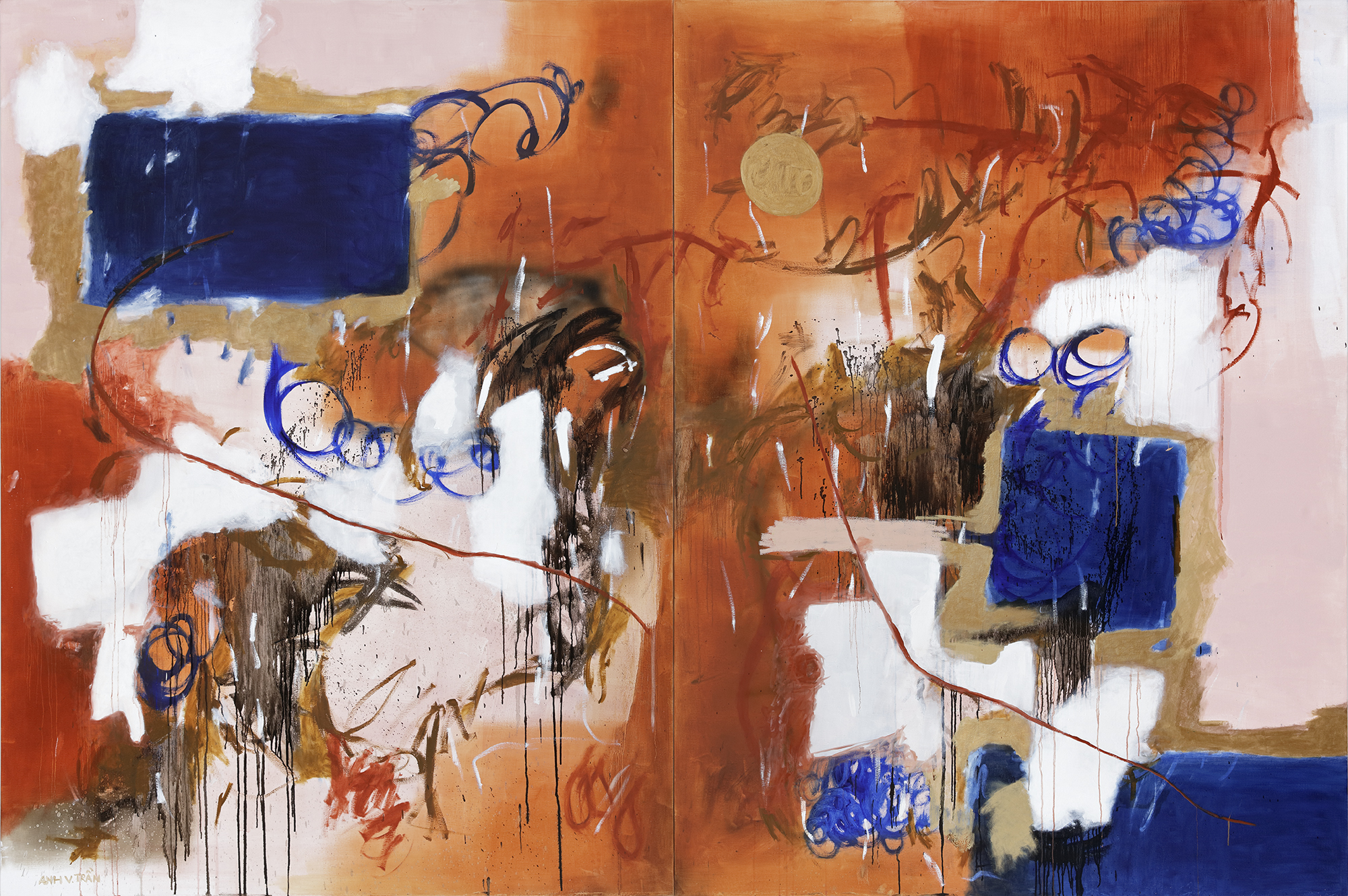“I don’t really, completely, believe in this expressive individualism. I understand how it starts, but I don’t totally agree with it”
Born in Bến Tre, Vietnam, Anh Trần studied painting in Auckland and Amsterdam, and now lives in Berlin. Following breakout showings in 2022’s Biennial of Painting at Museum Dhondt Dhaenens, Deurle (curated by Gabi Ngcobo and Oscar Murillo), and the 58th Carnegie International, she has had solo shows at Amsterdam’s Fons Welters, Berlin’s Société and Paris’s Fitzpatrick Gallery. Trần’s tumultuous canvases outwardly speak the language of expressive abstraction: she makes big, often multipart works full of colliding, kinetic gestures in a variety of paint media – oil, acrylic, Flashe vinyl, spray. Perhaps appropriately, given her peripatetic history, her compositions never quite feel located in one place, or one kind of place: they’re rich in intimations of physical space, rivers and vistas, while also being acts of improvisatory, intuitive markmaking that telegraph stormy mental worlds; they contain elements that suggest letterforms, but defer outright articulation. Nevertheless, that resistance to stability is pointed and personal in its own way: at 2024’s Art Basel Parcours, for example, Trần exhibited two paintings, avowedly keyed to Renaissance gold and Byzantine blue, in the choir of the St Clara Church: she titled this showing every water has the right place to be, a theme that, an accompanying text neatly suggested, ‘elicits notions of fluidity, mutability, and the search for a sense of belonging – a commonality shared by Trần’s painting practice and the rituals surrounding religious experience’. The first time I met Trần, for a studio visit in Berlin’s Charlottenburg in 2023, we discussed the dynamics and flows of her paintings awhile and then she said that the act of painting in a style rooted in Abstract Expressionism was for her, a Vietnamese woman, a kind of performance. I was intrigued by that, and we agreed to talk again, this time on the record. Here, as well as unpacking those performative aspects, she speaks about the points where abstraction meets the real world; painting as an act of empathetic reaching-out and of maintaining space for unknowing; the importance or otherwise of identity; and her shamanistic family tree.
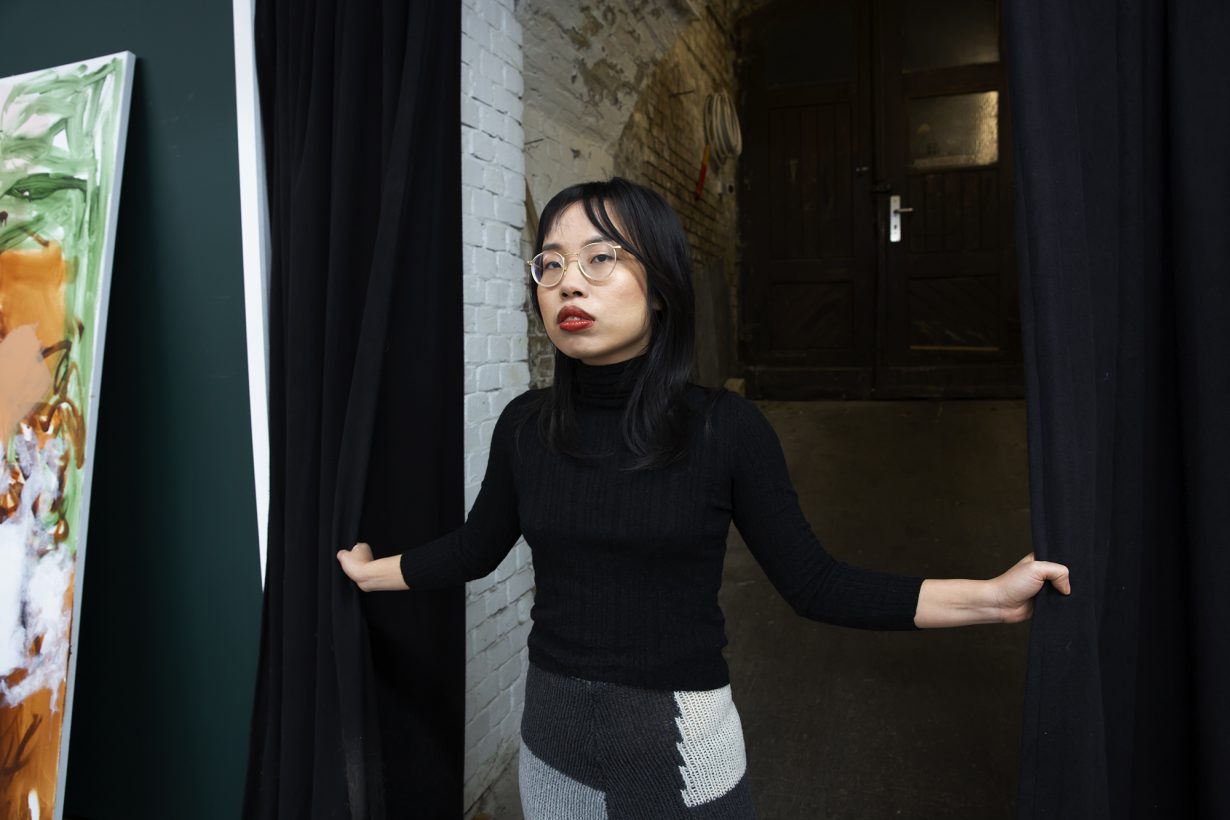
Quite Bad
ArtReview The titles of your paintings often suggest a sense of wanting, yearning. Some include the word ‘rescue’, several are about the sky as a place of possibility. They seem to point towards a desire to connect, or to get somewhere. One thing that stresses out many art viewers is an abstract painting called Untitled, a refusal to hint at the painting’s content or meaning; conversely, you seem to want to offer a few clues.
Anh Trần I keep a notebook of titles, and they’re mainly in English. I want them to have melody, to be poetic, and the titles of my exhibitions also represent the different ‘chapters’ I work with. I used Searching the Sky for Dreams as a title for a long time, changing the subtitle. I’m not interested in placing the human experience at the centre of the universe; it’s also about a connection between the human body and everything else around it. I believe that’s how we can connect to each other. Related to that, it’s also not my ultimate goal to make a single, very beautiful painting – I never think of it that way. It’s always a continuing process.
AR There’s a strong, almost productive sense of unfixedness and incompletion within the paintings themselves – they tend to suggest an event happening before your eyes, emerging or passing by, and the markmaking is varied and dynamic, as if in conversation with itself. The works sometimes look like a natural landscape while also feeling like interior, emotional landscape. And, formally, they’re somewhere between painting and drawing, mixing a liquid background and swaths of paint with lively line-making…
AT Right, that’s just how I work, I never do drawings first. And I compare it to making a videowork, with lots of screens and layers in one canvas. It seems like I’m recording something, even if that’s the landscape of my feelings, or the landscape outside the window, or what’s going on in the canvas itself, between marks and forms and colours. So, it’s a continuation of something that’s moving around, and moving from canvas to canvas. I can never work on just one painting – it always has to be at least two or three. I guess it’s also a reflection of the times, there’s so much we see, so much going on – on the internet or whatever – and I grew up with that, so it affects how I see pictures. If I focus on just one painting, it’s guaranteed to be quite bad.
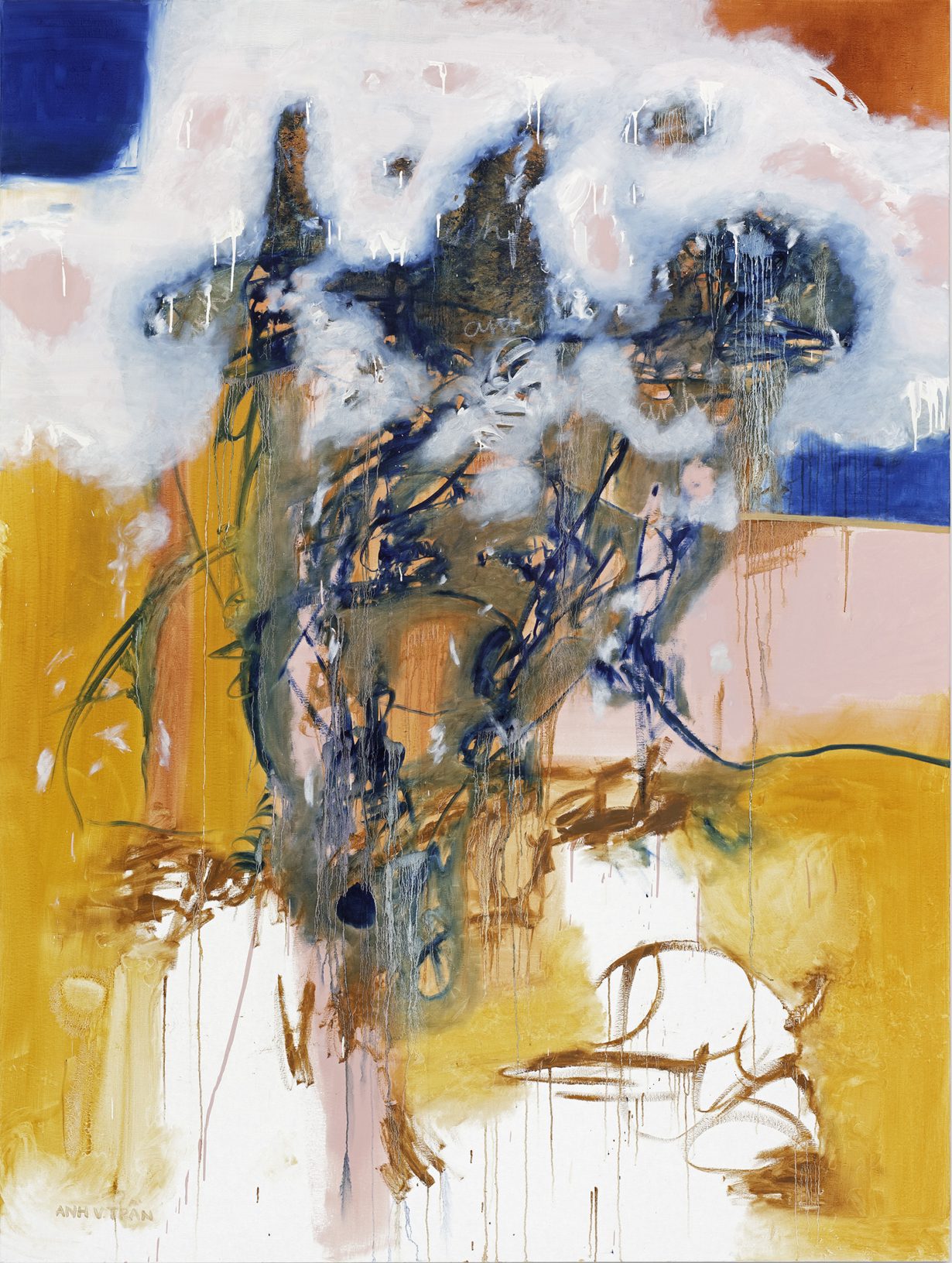
On the Importance of (Not) Being Yourself
AR Aside from these ideas of connection, which we’ll come back to, you’re working in a variant on a visual language – expressive abstraction – that was originally identified with Western men and with a twentieth-century ideology of individualism and, mainly, masculinity. Meanwhile, you come from Vietnam, a country that was colonised by France, and you studied in another colonised country, New Zealand, and you’re a woman. Someone could say that on one level these paintings are ‘about’ who gets to articulate themselves through abstraction, and/or that, on another level, they’re a kind of reverse colonialism.
AT Yes, but those ideas came later. When I started painting, that wasn’t my original idea. I didn’t know what painting was like when I was in Vietnam – I never really saw contemporary Vietnamese art, let alone paintings. I started painting in New Zealand, and at the university, 12 or 13 years ago, there seemed to be a certain way of doing it. I learned this as a language – Western abstract painterly language – a separate language, besides the English language, and what I’m trying to do is to use it until I feel at ease with it, I guess. If I perform as a New Zealander, this is how it works.
AR When we first met, you talked in terms of making paintings as a kind of a performance, which I thought was surprising and interesting, and in other interviews you’ve said that in a studio space you follow a set of manners as a ‘Pākehā [European] New Zealander’.
AT When I come to the studio it’s quite spiritual – I can’t paint in front of other people, so it’s difficult to share a studio [laughs]. It’s a place where I feel safe enough to be alone and have a lot of freedom to make the work I want. Outside the studio, I feel like a different person – a Vietnamese living overseas, I guess. I don’t have my painting at home, I’d rather not look at it outside the studio. But what you said before, of course it’s a fact that I’ve been moving to these [colonised] countries, but I don’t really hold onto it too much when I paint, because it would be quite depressing.
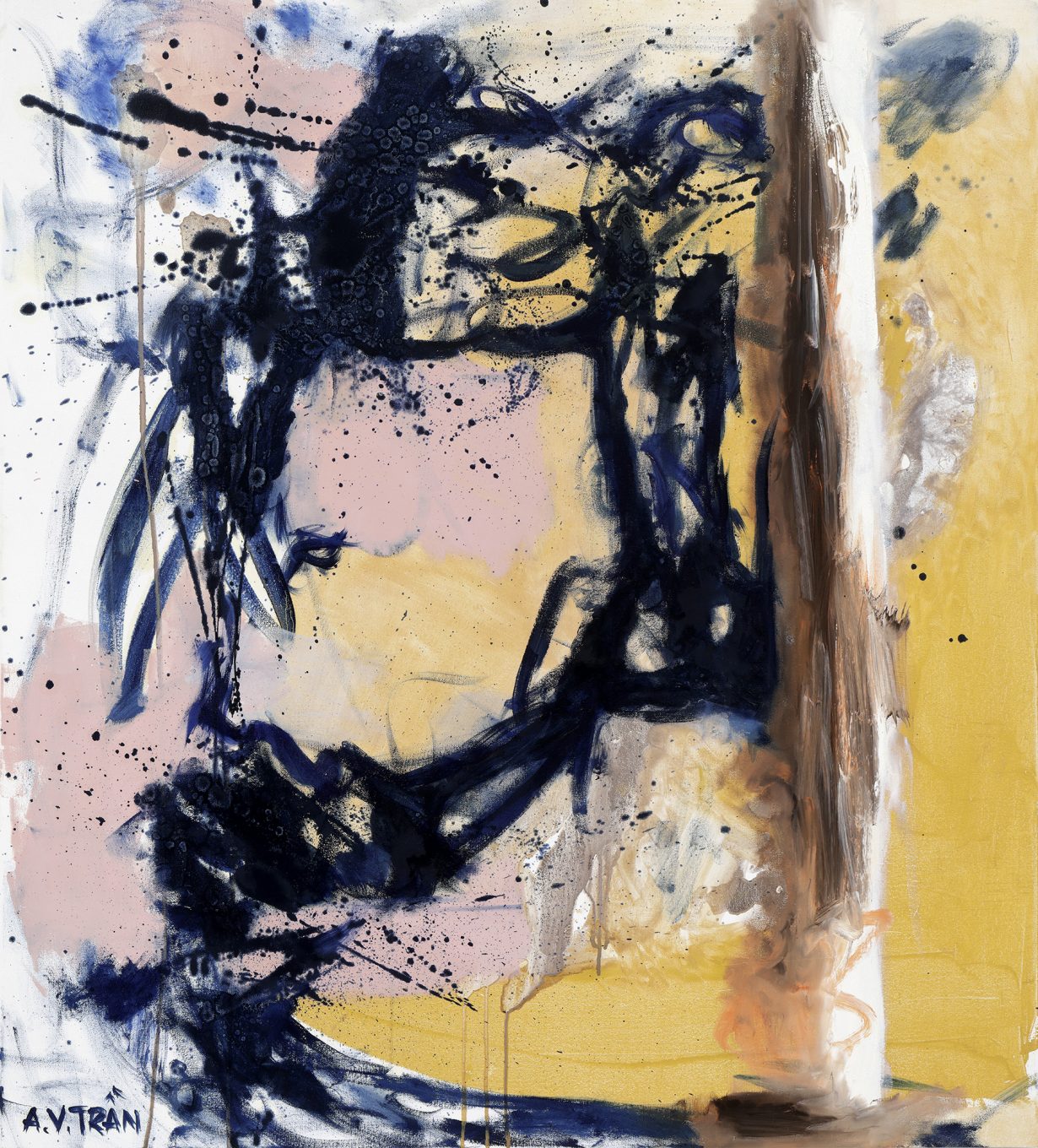
AR Couldn’t it also be liberating in a way? It might suggest there’s continued life in this language, expressive abstraction, and that part of it maybe comes from different people working with it, bending it, bringing something of where they come from to it.
AT Yes, that’s precisely what I want to say. In my head, in my imagination, maybe it’s utopian, but when we talk about this relationship between the USA and Vietnam, it’s like – what if there hadn’t been any war, but the relationship changed and the Vietnamese got to do these abstract paintings as well? But, of course, that is a very utopian idea, because Abstract Expressionism was used by the CIA as anticommunist propaganda, and of course communism was very strong and present in Vietnam. So, I guess maybe what I mean is a resistance to this oppressive political agenda on both sides.
AR Another thing you’ve mentioned in the past, and this perhaps keys into the performative, shapeshifting aspect, is that your maternal grandmother was a shaman.
AT She’s passed away, but my mother talks about her all the time, and I did visit her a few times in my life. Again, it’s quite foreign to me, but somehow it’s in my blood. Shamanism seems to have become a trendy theme in recent years, in biennials, with artists of different nationalities referencing it, etc. But it’s also a very Indigenous Vietnamese practice, even before Buddhism, and not well known outside Vietnam, even in the south of the country, where I was born and grew up. It’s more in the north, where my mother comes from. Perhaps there is a relationship between this aspect where the shaman is changing form and who I am when I’m painting. It’s useful to think that that could be a possibility, that I’d not be caught up with my preexisting identities and wouldn’t have to make the paintings I feel like I’m supposed to make. I have to create another world. But I’m not completely someone else when I do that; it’s also part of me.
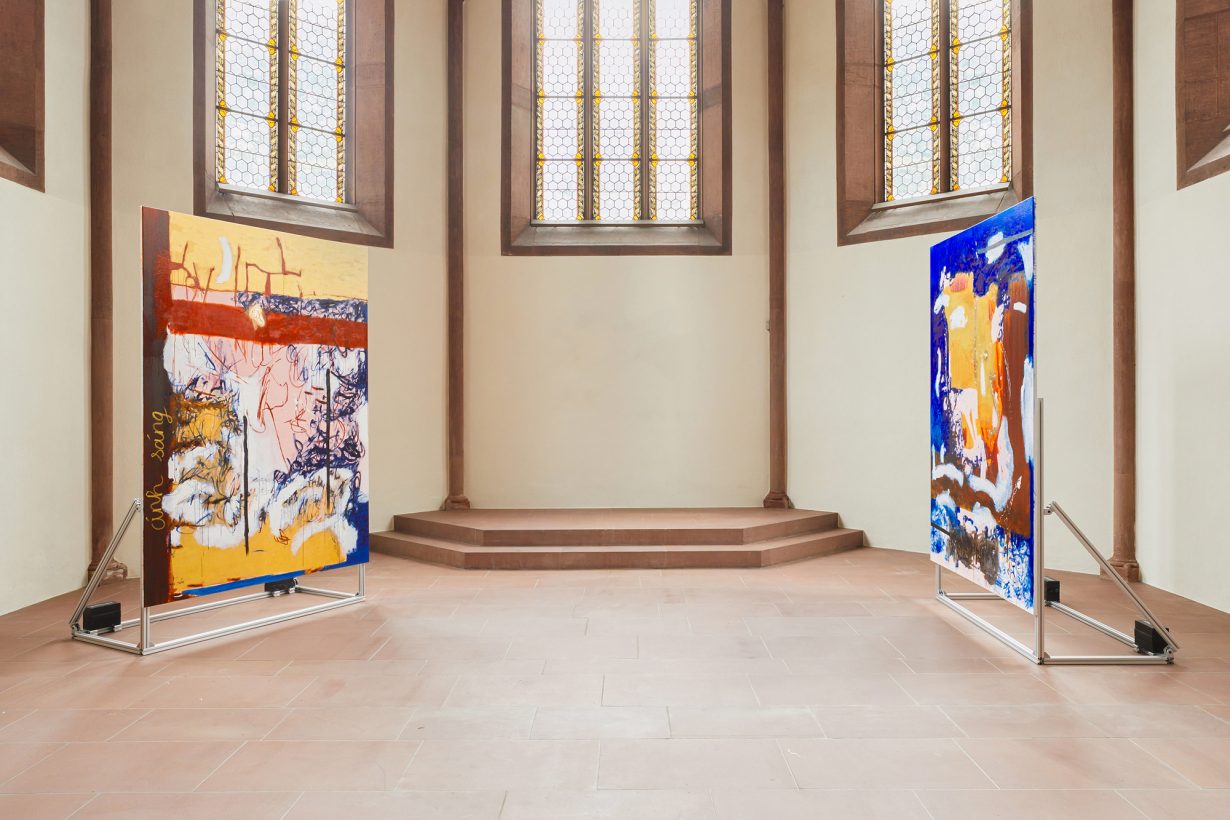
A Sense of Familiarity
AR How important, then, is your biography in this work?
AT I don’t necessarily hope for the viewer, the audience, to connect who I am with the work when they’re looking at it. To go back to connection, to starting a conversation, if someone really cares about my identity, where I’m coming from, and that enables them to understand my work, why it is the way it is – then I hope for them to start thinking about their own identity, what their relationship to the painting is.
AR So even if identity concerns could be a way in and even a way out, it all has to come back to the wordless experience of standing in front of an abstract painting, navigating it.
AT That’s the radical idea. Painters in general, we want to do this. We want to make a very good abstract painting, but in the space where people can see it and be moved by it and have certain feelings without understanding what they’re looking at. That’s the beauty of painting. But in my case that’s not enough, I can’t just do that; I feel like it’s never enough just to do that.
AR That would seem to lead us back to connectivity, between the human and everything else, and the sense of movement in your paintings: that they can suggest interior space and different kinds of physical, landscape space, and have fragments of language in them: different worlds joining up.
AT The simplest way I can explain the painting process is that I’m trying to make a relationship between figure and ground. I start with a background – I did a lot of watercolour at school and my oil paint is quite watery, fluid – and then comes the figure, quick gestures, more bold and darker colour, and the second thing I’m thinking about is colour. I design the palette before I start the painting, and I tend to use blue a lot. Recently, when I had a project in a church for the Art Basel Parcours, I used a lot of gold, and the idea behind that was that gold is quite Christianity-related in Europe, quite Western, Renaissance gold, antique gold, and the blue lately was mainly a Byzantine blue – they used that a lot for churches. So it was to create a sense of familiarity or symbolism for the viewer, but the way I use those colours, it’s not constrained to a certain set of rules.
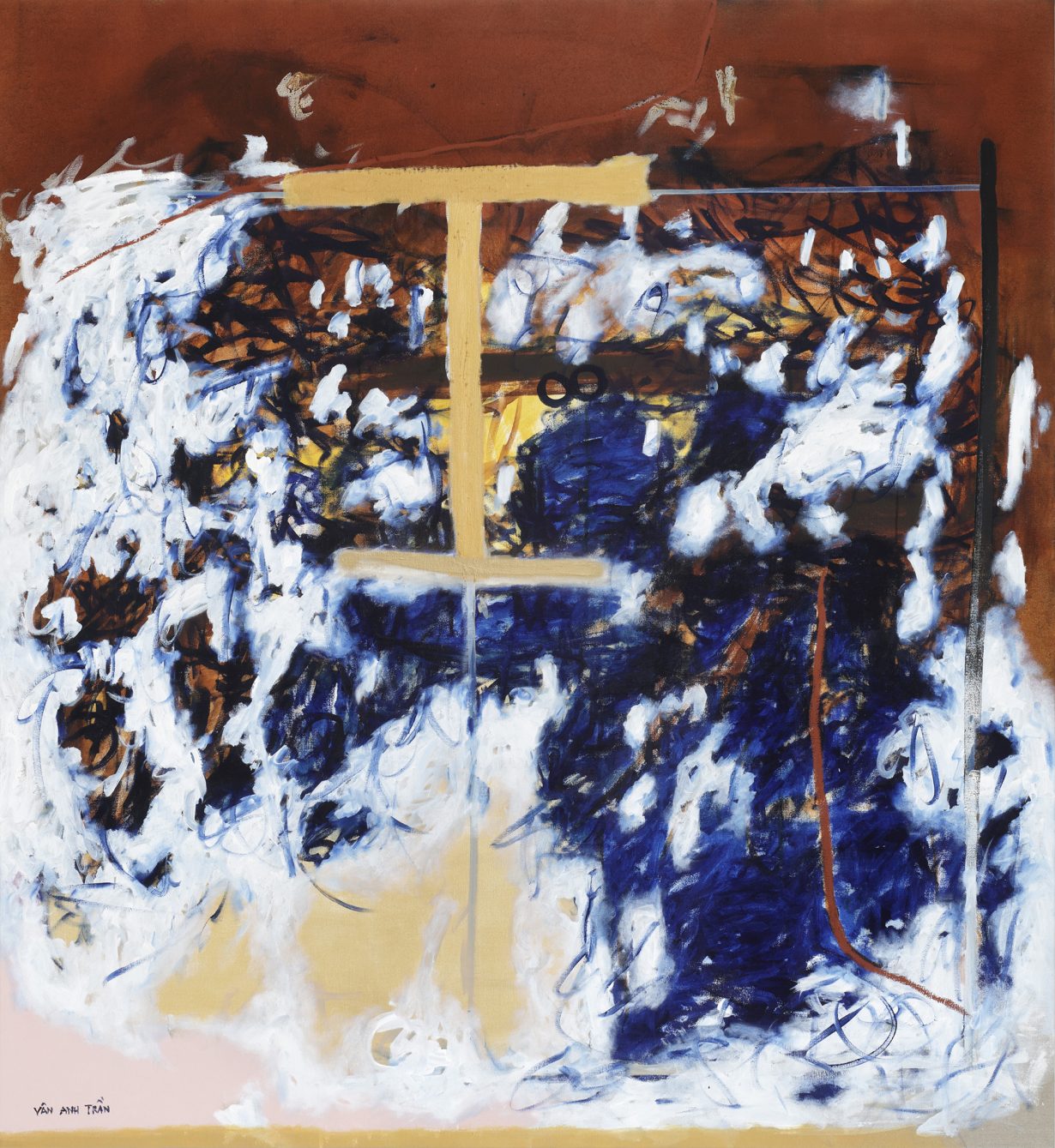
Big and Complicated
AR This balance between the familiar and the unknown repeats on an iconographic level, I think. You use shapes that might be letterforms, and there’s a horizontal mark that recurs in your work, tending towards the centre of the canvas; it’s just a thick line, but it might be a horizon line, or a river.
AT It used to be the river, a mark I’ve been making since I came to Europe almost five years ago. But I think fundamentally it’s a way for me to pull back from these expressive, chaotic, very busy backgrounds – the mark just balances it out and holds things together. But you’re right, I keep repeating it unconsciously, so it must mean something to me. It’s a landscape. Sometimes it’s a kind of text, depending on the context of the show. One other thing to say is that the paintings are quite large, in terms of their scale in relation to my body. And the larger they are, the more complex. When I look at the work, I can only see one section at a time rather than the whole picture. That’s very important for me, in the process of painting. It means I’m surprised all the time, when making, and I like the surprise. I guess in the end it’s because I don’t want to put too much of myself into the work, and maybe there comes the performance that we were talking about.
AR Why don’t you want to put too much of yourself in the work?
AT Because I don’t really, completely, believe in this expressive individualism. I understand how it starts, but I don’t totally agree with it. It’s not my absolute belief. The paintings should be, again, a conversation, a bridge, between things and between people. It should be an interaction. The work is a medium; it’s not about me.
From the January & February 2025 issue of ArtReview – get your copy.
